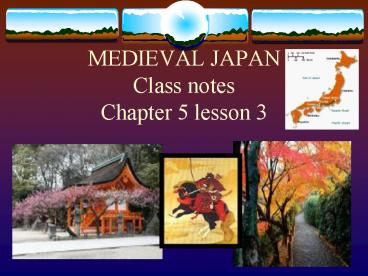MEDIEVAL JAPAN Class notes Chapter 5 lesson 3 - PowerPoint PPT Presentation
1 / 13
Title:
MEDIEVAL JAPAN Class notes Chapter 5 lesson 3
Description:
MEDIEVAL JAPAN Class notes Chapter 5 lesson 3 LIFE IN MEDIEVAL JAPAN I. JAPANESE RELIGION AND CULTURE 1. During the Middle Ages, Japanese people practiced both Shinto ... – PowerPoint PPT presentation
Number of Views:169
Avg rating:3.0/5.0
Title: MEDIEVAL JAPAN Class notes Chapter 5 lesson 3
1
MEDIEVAL JAPANClass notesChapter 5 lesson 3
2
LIFE IN MEDIEVAL JAPAN
- I. JAPANESE RELIGION AND CULTURE
- 1. During the Middle Ages, Japanese people
practiced both Shinto and Buddhism. There was no
need to select one religion over the other. - In the same time period in Europe could
Europeans practice both Christianity and Judaism
or Christianity and Islam?
3
- 2. By the time it reached Japan, Buddhism had
divided into different sects, or smaller
religious groups. - How many Christian
- religions or sects have
- evolved from the Catholic
- faith in Europe?
4
- 3. Pure Land Buddhism was a sect that stressed a
happy life after death. - 4. Zen Buddhism is another important sect of
Buddhism brought to Japan from China. Zen teaches
that people can find inner peace through
self-control and a simple way of life. - Why do you think the Samurai class adopted
- these religions easily?
5
- 5. Japanese art reveals the Japanese love of
beauty and simplicity. Art in the Middle Ages
included wooden items coated in lacquer,
landscape paintings, folded paper called origami
and tea ceremonies.
ORIGAMI ART
LACQUER FURNITURE
6
- 6. Japanese buildings were influenced by Chinese
or Japanese styles. Shinto shrines followed
Japanese styles while Buddhist temples followed
Chinese styles.
BUDDHIST TEMPLE
SHINTO SHRINE
TORII GATE
7
The famous floating Torii gate near Hiroshima
8
- 7. The Japanese borrowed and adopted the Chinese
style of writing using characters. Calligraphy,
the art of writing beautifully, was important in
Japan.
9
- 8. The tanka is Japans oldest form of poetry.
The haiku is a poem that is based on syllables
with a 5-7-5 pattern. - 9. The Tale of Genji written by Murasaki Shikibu
(SHE-KEY-BOO), was about a Japanese prince in the
year 1000 AD. - 10. Noh plays taught Buddhist ideas and were
performed on a bare stage by actors wearing robes
and masks.
Can you think of any tales written in Medieval
Europe that have helped historians reveal what
life was like in Europe in that time period?
10
- II. ECONOMY AND SOCIETY
- 1. Very few people benefited from Japans wealth
under the shoguns. Most people in Japan remained
poor. - 2. Japanese farmers worked hard to grow rice,
wheat, millet, and barley in the 1100s, advances
in irrigation and crops allowed them to grow more
food and their lives improved.
11
- 3. Artisans made weapons, armor, and tools for
merchants to sell. As trade increased, artisans
began making pottery, paper, textiles, and
lacquered items. - 4. Kyoto, the capital of Japan, was a major
center of production and trade
Why is the capital of Japan today Tokyo and not
Kyoto? Why did the capital city move often?
12
- 5. Japanese women had less freedom than men but
despite their lack of freedom, some women made
important contributions to Japanese culture.
During the time of Shotoku, wealthy women could
be rulers and own property. However, women lost
those freedoms after the samurai and daimyo took
control. Marriages were arranged by fathers in
noble families.
13
STUDY REVIEW FOR 5.3 QUIZ
- Know the difference between Pure Land Buddhism
and Zen Buddhism. - The importance of the novel The Tale of Genji
by Murasaki Shikibu. - Understand the life of the average person during
the Shogun period. - Life of Japanese women and when they lost
freedoms in society. - Understand meanings / importance all of the
highlighted key terms, people and places.































